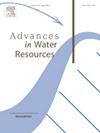Quantifying the performance of the horizontal less permeable barrier in improving the maximum sustainable withdrawal rate in coastal aquifers
IF 4.2
2区 环境科学与生态学
Q1 WATER RESOURCES
引用次数: 0
Abstract
Horizontal less permeable barriers have been proposed as a viable approach for reducing seawater intrusion in coastal aquifers. However, the performance of such barriers on enhancing coastal well pumping remains unclear. This study presents an analytical model based on the potential theory capable of evaluating the effect of a horizontal less permeable barrier on the maximum sustainable withdrawal rate in a finite-domain coastal aquifer. The model contains a steady-state groundwater flow equation that includes a Dirac delta function representing the pumping well, a constant-head coastline boundary, a constant-flux inland boundary and no-flux lateral boundary conditions. A localized equivalent hydraulic conductivity is applied exclusively within the barrier region and its adjacent aquifer interface zone. The solution is derived using the finite Fourier Cosine transform. Numerical simulations employing the variable-density flow code SEAWAT are conducted to validate the proposed analytical solution, and the analytical results align well with the numerical simulation results. The sensitivity analysis based on the analytical solution and dimensionless parameters reveals that the maximum sustainable withdrawal rate can be up to twice as much as the rate without the barrier as the dimensionless equivalent hydraulic conductivity decreases. Additionally, as the dimensionless length of the barrier increases, the withdrawal rate exhibits a significant increasing trend before reaching a plateau. In a rectangular aquifer, the pumping well located closer to the inland boundary and nearer to the axis of symmetry along the shore corresponds to a higher maximum sustainable withdrawal rate. Furthermore, the maximum sustainable withdrawal rate is an order of magnitude more sensitive to the aquifer aspect ratio and the dimensionless hydraulic parameter than to the dimensionless transverse dispersivity. These findings offer valuable insights for constructing less permeable barriers to migrate seawater intrusion and for deploying pumping wells in coastal areas. The proposed analytical framework provides a flexible basis for analyzing coastal aquifer problems involving pumping wells, aquifer heterogeneity, and complex boundary conditions.
量化水平低渗透屏障在提高沿海含水层最大可持续回采率方面的作用
水平低渗透性屏障被认为是减少沿海含水层海水入侵的可行方法。然而,这些屏障在提高沿海油井抽水方面的性能仍不清楚。本文提出了一个基于势理论的分析模型,该模型能够评估水平低渗透屏障对有限域沿海含水层最大可持续采收率的影响。该模型包含一个稳态地下水流动方程,该方程包括一个代表抽水井的狄拉克δ函数、一个恒定水头的海岸线边界、一个恒定流量的内陆边界和一个无通量的横向边界条件。局部等效水力导电性仅适用于屏障区域及其相邻含水层界面区。解是用有限傅里叶余弦变换导出的。利用变密度流代码SEAWAT进行了数值模拟,验证了所提解析解的正确性,分析结果与数值模拟结果吻合较好。基于解析解和无量纲参数的敏感性分析表明,随着无量纲等效水力导率的降低,最大可持续抽采速率可达无障时抽采速率的两倍。此外,随着屏障无因次长度的增加,回撤率在达到平台之前呈现出显著的增加趋势。在矩形含水层中,靠近内陆边界和靠近海岸对称轴的抽水井对应着更高的最大可持续采收率。此外,最大可持续采出速率对含水层宽高比和无因次水力参数比对无因次横向分散度更敏感一个数量级。这些发现为建造低渗透性屏障来迁移海水入侵以及在沿海地区部署抽水井提供了有价值的见解。所提出的分析框架为分析涉及抽水井、含水层非均质性和复杂边界条件的沿海含水层问题提供了灵活的基础。
本文章由计算机程序翻译,如有差异,请以英文原文为准。
求助全文
约1分钟内获得全文
求助全文
来源期刊

Advances in Water Resources
环境科学-水资源
CiteScore
9.40
自引率
6.40%
发文量
171
审稿时长
36 days
期刊介绍:
Advances in Water Resources provides a forum for the presentation of fundamental scientific advances in the understanding of water resources systems. The scope of Advances in Water Resources includes any combination of theoretical, computational, and experimental approaches used to advance fundamental understanding of surface or subsurface water resources systems or the interaction of these systems with the atmosphere, geosphere, biosphere, and human societies. Manuscripts involving case studies that do not attempt to reach broader conclusions, research on engineering design, applied hydraulics, or water quality and treatment, as well as applications of existing knowledge that do not advance fundamental understanding of hydrological processes, are not appropriate for Advances in Water Resources.
Examples of appropriate topical areas that will be considered include the following:
• Surface and subsurface hydrology
• Hydrometeorology
• Environmental fluid dynamics
• Ecohydrology and ecohydrodynamics
• Multiphase transport phenomena in porous media
• Fluid flow and species transport and reaction processes
 求助内容:
求助内容: 应助结果提醒方式:
应助结果提醒方式:


